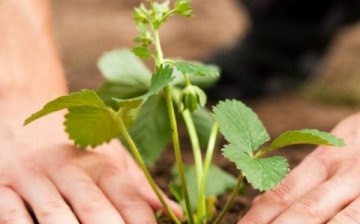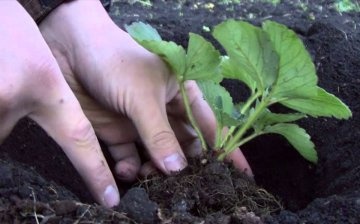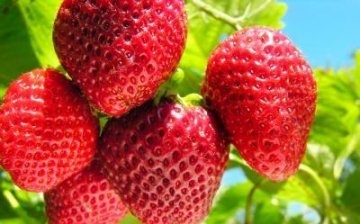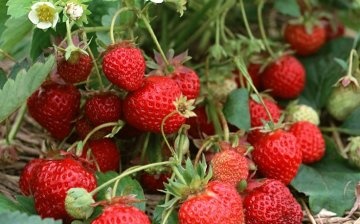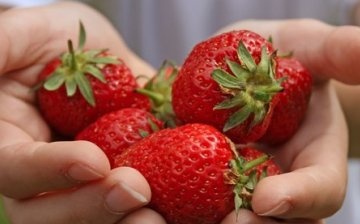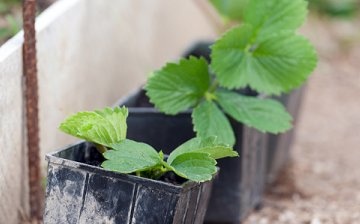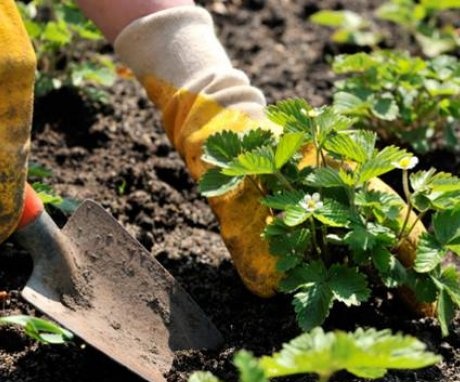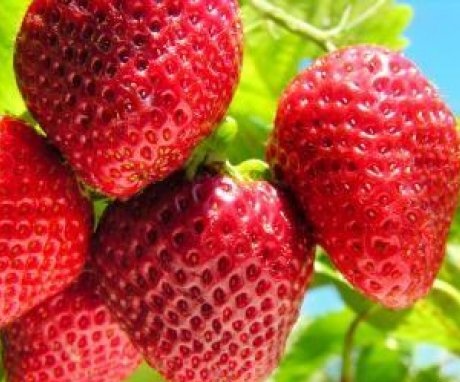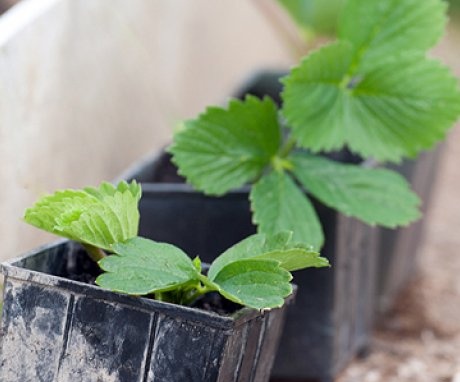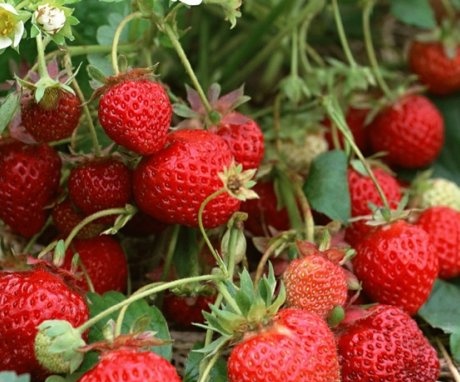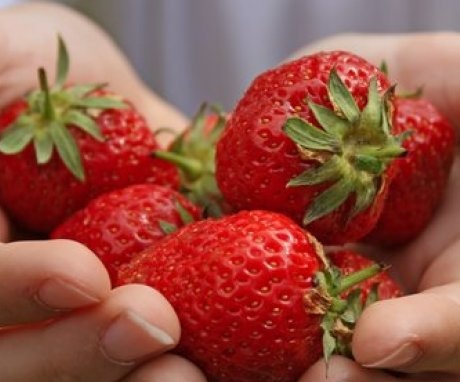Rules for planting strawberries in the fall: soil selection, planting dates and wintering of strawberries
Strawberries are a messenger of warmth and sun. She is one of the first to ripen in summer in summer cottages, is healthy and fragrant. Strawberries can be called a storehouse of vitamins for people who have weakened over the long winter. The therapeutic effect of diabetes, vitamin deficiency, hypertension, atherosclerosis, anemia and many different diseases is possible due to the most successful combination of antioxidants with trace elements.
Content
- What kind of soil is suitable for the berry?
- Planting dates for strawberries
- Strawberry varieties
- Planting: planting material
- Berry care
- Wintering strawberries
What kind of soil is suitable for the berry?
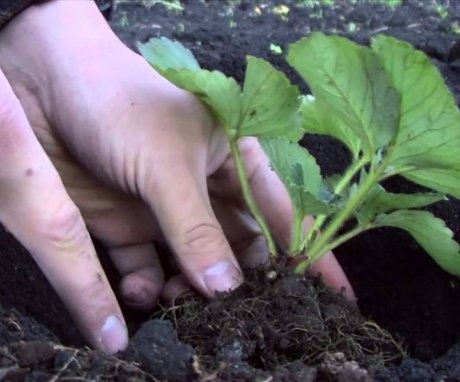 ?
?
The berry is not very demanding on luxurious conditions in terms of soil, it bears fruit in a wide variety, excluding swampy places. But strawberries have some flaws, faced with which, novice gardeners are frightened. It is unclear why the berry has dried up, bears little fruit or is attacked by harmful insects.
Experienced summer residents have already got the hang of it and have their own tricks and secrets, but for beginners sometimes it is difficult. I want to get consistently good yields and not bother. But the trouble is - there is no universal "magic wand", and there is nowhere to get knowledge. As a remedy for troubles, you can advise planting a strawberry crop in the fall.
Fall planting has many benefits. Here are the most basic ones:
- A good yield is obtained with little effort from summer residents.
- Old, neglected strawberry meadows can be restored quickly and successfully.
Meanwhile, pay attention to the ground all the same it is necessary. Add humus or peat to the clay soil for better aeration. You can also sow lupine or mustard - siderates. Siderata are sown in spring, and when they bloom, they are mowed and buried.
This approach will improve the soil structure, prevent the growth of weeds, for example, wheatgrass, help fight insect pests, and enrich the soil with nitrogen.
After you close the green manure, the ridge will become cleaner and will be enriched with useful microelements. In addition, there is a good saving on fertilizers, difficulties with their introduction and destruction of weeds.
Planting dates for strawberries
There are early autumn, mid-autumn and late autumn berry planting. The first is held from the fifteenth of August to the twentieth of September, the second from the twenty-fifth of September to the fifteenth of October, and the third ends one month before the early frosts. Different areas of the country suggest different planting dates. You need to be guided by when the strawberry throws out the mustache.
Best of all, strawberries of early autumn and mid-autumn planting bear fruit, since late strawberries are more often damaged by early frosts.
There are varieties in which fruiting occurs twice, so the second harvest will have to be sacrificed. From the twentieth of August to the twentieth of September, there is an optimal period for planting strawberries.
In this case, the seedlings will have time to get stronger before frost, and the fruit buds will form correctly. All that is required is attentive and careful plant careand.
Strawberry varieties
I would like to tell you a little about varieties and their choice... The ideal option would be if you try strawberries, find out the resistance to various pests and diseases, and find out the reproduction rate.
A beautiful advertising campaign will not always tell the truth, so don't take advertising seriously and don't buy varieties that are intended to be grown on an industrial scale, for example, Queen Elizabeth II, Gigantella, Brighton. Yes, they have good dense berries, they do not wrinkle much during transportation, but not everyone will like the slight dryness of the pulp.
It will be best if there are two early-ripening varieties on the garden plot, for example, Julia or Olvia, or medium-term fruiting ones - Lord or Elephant.
If there are no other options, then take remontant varieties - Vima Rina or Albion. Try to give preference to disease-resistant and fast-propagating varieties, such as Chamora Turusi, Clery and many others. It is advisable to take varieties with a rather large berry size. The bigger, the better.
Planting: planting material
How to purchase quality planting material? In summer or autumn, gardeners thin out strawberry meadows, it is at this time that you need to buy seedlings, since there is an opportunity to see with your own eyes what it is “on the ground”, to understand whether the plants are healthy. Excellent seedlings can come from even a neglected and old strawberry bed. There is only one taboo: she should not be sick. But all the same, it will take two years to fully restore the ridge.
Planting strawberries in autumn can rejuvenate existing beds.
It will be ideal if you split the ridge into four parts and sow one part with siderates, and in autumn with strawberries. The yield will be significantly higher on one part, and the other three will simply "rejuvenate".
Strawberries you already own can also be used to grow good planting material. For this:
- Choose healthy, with good fruiting bushes, dig in their first three mustache. You can immediately drop the mustache into the ground of the container.
- When the antennae take root, it is necessary to pinch the antennae growing further.
- Since the first-order antennae (the first rosettes) are the most fruitful in strawberries, you will get healthy and strong plants, but if you pinch the second-order antennae, then you can provide them with nourishment from the mother bush and grow quite quickly.
Little antennae leaves the mother's well-fruiting bush, but this does not mean at all that you need to get upset and turn your attention to less fruiting bushes just because they have more whiskers. Stick to the saying "Less is more," and everything will be fine.
Young, but already matured bushes are separated from the mother bush right before planting in open ground. It is worth planting on a cloudy day or at the end of the day in damp ground. Plant without deepening the root collar of the plantand then carefully. but pour abundantly. Young shoots must first be shaded on hot days, often watered and loosened the soil around them. If you want the strawberries to take root 100% in each hole, then you can plant two plants in one hole, or plant several plants in case the young seedlings die or freeze.
Berry care
But even without fiddling with siderates, planting berries in the fall can be of great benefit. Start fertilizing need in the spring. For 1 sq. m will require eight kilograms of humus, fifty-five grams of potash salt and ninety grams of superphosphate fertilizers. Also, in the future place for berries, it is necessary to plant vegetables that sprout early. They will have time to produce crops, and the area will be used efficiently. But you don't need to grow potatoes with eggplants and peppers with cabbage and cucumbers. From them pests can remain.
Watering strawberries:
- Strawberries love moisture, so regular watering is needed all the time.
- Another plus of autumn planting is that watering should be carried out two or even three months less.
- Of course, both in the spring and in the autumn planting, a drip irrigation system will be required, therefore the economic benefit and the benefit of labor costs are obvious in the autumn.
Autumn planting is also good in that the berry seedlings receive a sufficient "charge of moisture" to take root and form a harvest for the next year. Because of this, it will bear fruit already at the end of spring.
Strawberries love moisture, but you need to be able not to overdo it, as waterlogging of the soil can lead to fungal diseases and rot.
Mulching or loosening will help to avoid excessive watering, among other things, this method will help to avoid the appearance of weeds. The material with which you mulched strawberries - straw, cut siderates, must be collected and burned in late autumn in order to avoid the spread of various diseases, because autumn plowing is carried out in October. But you can leave the needles. It will keep warm in winter, and in spring, when the thaw begins, let the air pass through. At the time when the fruits appear, the needles will help maintain the clean, beautiful appearance of the strawberries.
Wintering strawberries
Refusal to plant autumn strawberries is often due to the fear of freezing the berries. But here's the weirdness! Under a ten-centimeter snow layer, the plant can tolerate even very low (up to thirty degrees of frost) temperatures. But if there is no snow, then the culture will suffer even at minus fourteen.
Of course, strawberries, which are constantly being cared for, winters much better, but there are still rules thanks to which they can endure the cold period. Here they are:
- On the southern slopes, the snow cover melts faster, so it is not worth planting berries there.
- Cover the strawberry bushes with needles in November.
- Create a system that will keep the snow near the strawberries and provide the minimum necessary for the berry to overwinter. A picket dug in the lower part of the garden can serve as it.
As you can see, the growing strawberries in the fall is not observed, and it will be within the power of even a beginner in gardening.
More information can be found in the video.



